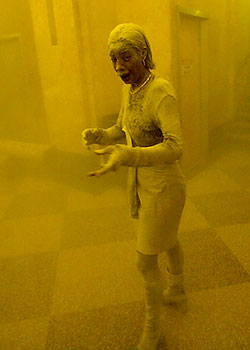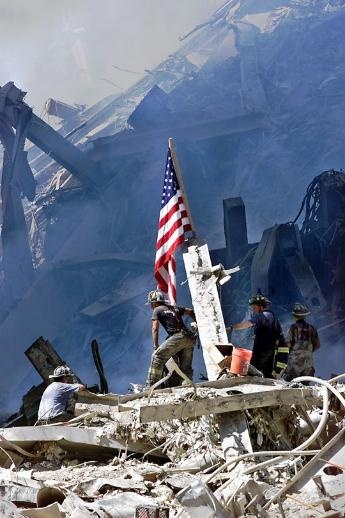Remembering 9/11: "This is How I'm Going to Die"
Army Major Thane J. Thompson was in the reserves, working for Morgan Stanley on the 61st floor of WTC Tower II, at the time of the 9/11 attacks. A Green Beret Medic, he went on to serve in the first wave of the invasion of Iraq. Thane has since completed a second tour in Iraq and continues on active duty at Fort Bragg, NC.
In this second installment of a three part series, he recalls what it was like when the first tower collapsed. Click here for part one, and part two.
NewMajority thanks contributor Sean Linnane for forwarding this material to us from Stormbringer, where all three parts can be viewed in full.
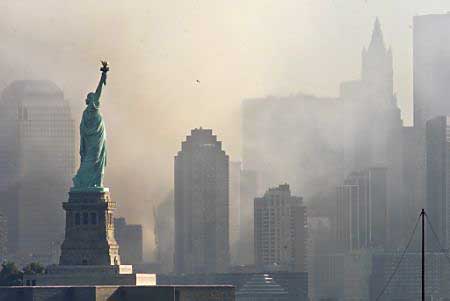 A debris cloud engulfs Lower Manhattan
A debris cloud engulfs Lower Manhattan
. . . so this is it. . . I thought, . . . this is how it happens. This is how I’m going to die . . .
NO! I’ve got to get out of here! The thick dust made it hard to breath and I assumed it was toxic. What does this dust have in it? Asbestos? Dioxin? I remembered seeing microscopic pictures of asbestos where the crystalline structure looked like a Christmas tree of razor blades; now I feared the thick dust and moved away into a storage area with construction and cleaning supplies that was farther back in the garage. The air there was still clean and dust hadn’t gotten there yet.
I rummaged around and found some clean rags, and made a makeshift mask by tying a rag around my head covering my nose and mouth. Some of the firemen had respirators on. They were searching the garage with flashlights. Their lights played back and forth inside the dust cloud searching for an exit.
Eventually, a shout went out amongst the fireman: an exit had been found! The news was relayed among the people in the garage. We followed their lights through the dark thick dust to a wall, then followed the edge of the wall toward rapidly dimming flashlights.
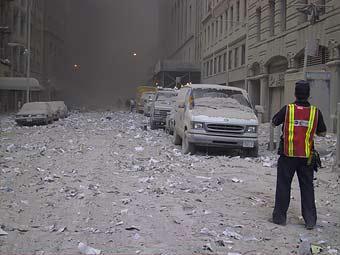 Rubble and soot from the collapsed towers blanked a New York street
Rubble and soot from the collapsed towers blanked a New York street
Outside was like being in heavy fog, visibility was no more than 6 feet. The air thick with dust had everyone without a mask was gagging. The rag around my nose and mouth gave me a feeling of protection. Thick dust covered the ground like snow; I followed foot prints.
Keeping a hand on the building to my left, I made my way around the base to the corner and continued for a half block. The dust cloud was so thick that stepping out of the cloud into the bright morning sunlight was dramatic, from a thick foggy dust cloud to bright clear sunshine.
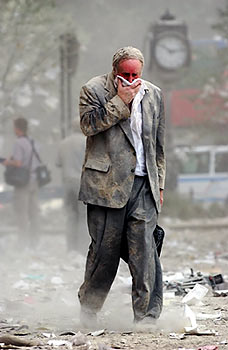 A stunned survivior walks away from Ground Zero
A stunned survivior walks away from Ground Zero
I was at the side of the building that I had just come out of. Immediately to my left against a building was an ad hoc aid station. Several office chairs surrounded by medical supplies were laid out on the sidewalk. A woman dressed as a nurse was arranging materials and giving directions to a helper. I walked up to the nurse, “I was trained as an army medic and would like to help.”
She welcomed the help. I asked people as they stepped out of the cloud if they needed help.
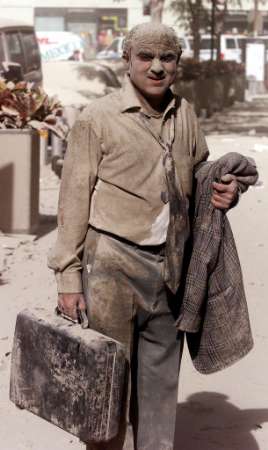 Another survivor emerges from the debris
Another survivor emerges from the debris
A man emerged from the dust cloud panting and in respiratory distress. He looked as though he had been spray painted with think gray paint. His eyes were watered as he tried to clear the dust. I set the guy down and washed the dust from his eyes. He panted and said “They hit us, they hit us in Washington D.C. too.”
This was not a total surprise to me; I had feared follow-on attacks. Now I knew what was next. The man was in good condition except for the dust and I told him to walk toward the bay. None of the people who stepped from the cloud were injured aside from dust in their eyes. The thought occurred to me that there were probably many people still in the cloud injured on the street. I waited a few minutes and no more people emerged from the cloud. I looked around and the nurse and the helper were gone; I don’t know where they went.
About 50 meters away I saw three ambulances arrive and begin to set up a triage point on the corner. Our little ad hoc triage station needed to link up with the main effort. From the nurses kit I gathered some supplies. I took an aid kit, an O2 tank, a backboard and went over to join up with an ambulance crew. I walked up to the three paramedics who were talking at the back of the ambulance. I explained once again, “I was trained as an army medic and I'd like to help.”
The medic said, “Sure.” He gave quick instructions on how he wanted to set up the gurneys and supplies and how he wanted to work the triage point.
A muffled crunch echoed down the streets. I looked up to the remaining tower and saw an arc of dust shooting out of the two closest sides of Tower 1. The building buckled in the middle and the upper section tipped towards us. “HOLY SHIT!” The building was falling towards us like a tree!
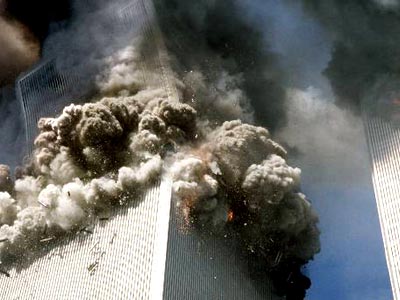 The first tower begins to collapse
The first tower begins to collapse
We were only a block away and the 110-story building would easily reach us, it would wipe out the surrounding blocks if it continued to topple like that. The panicky run for your lives feeling surged through me again. The medics ran to get in the trucks and I tossed the medical gear into the back of the ambulance and jumped in. The ambulance roared to life and we took off like the proverbial “bat out of hell.”
The transmission jerked, tires squealed, and we were out of there. Rapidly moving away from the crashing building and growing thunder, the doors to the ambulance were still open and we swayed from side to side as we swerved between people running on the street. I held on tight as equipment fell out of the back of the ambulance.
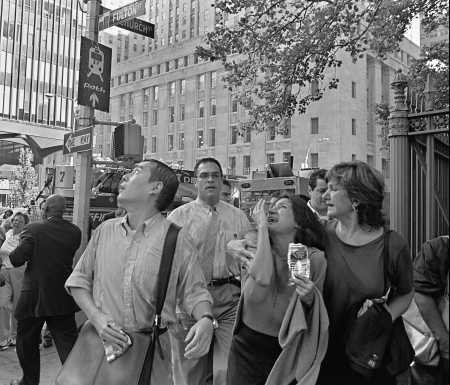 Onlookers watch the towers collapse
Onlookers watch the towers collapse
We raced north and a thick cloud of dust chased us. The cloud boiled with debris. The buildings were like canyons and the cloud flowed through them like the "Blob" in the old horror movie, only faster. As the dark, thick cloud rolled through the streets it engulfed people as they ran to escape. I was glad to be in the truck speeding away from the threat.
 Rescue teams head to the towers
Rescue teams head to the towers
My mind flashed again to the high school science picture of asbestos razorblade-like crystals. The cloud probably contains dioxins and God knows what else, I thought. Fear stoked my imagination again with the possibility of chemical, biological and radiological additives that the terrorists could have added to their suicide planes. Anyone could make a dirty bomb. What evil had the terrorists added to their mix of destruction?
The cloud was evil! As the ambulance sped down the street with the cloud in pursuit, I could only hold on and watch in horror as more people disappeared into it. The truck screeched to a stop, back doors banging loudly on the side of the ambulance as the driver shouted "EVERYBODY OUT!".
I looked around the back of the ambulance looking for some gear that might help if the menacing cloud consumed me. Grabbing the O2 tank, thinking it might help me breathe, I jumped from the ambulance into a dead end alley, then ran through a narrow pedestrian passage at the end of the alley as the cloud got closer.
The narrow passageway opened onto an elevated walkway above the bay. I turned east and ran. The bay was on the left side and a long five story building on the right. In the water to my left was a marina with sailboats moored to buoys. The walkway was filling with people as they poured out of the five story building. Everybody was walking east.
Let’s move it! I thought, Haven’t you seen the evil cloud coming for you? We passed a second double exit where even more people joined the flow. The new additions to the stream of people caused our progress to slow further. I walked with my left hand on the guard rail of the walkway. No sign of the cloud and the sunlight twinkled on the wavelets as the sailboats bobbed.
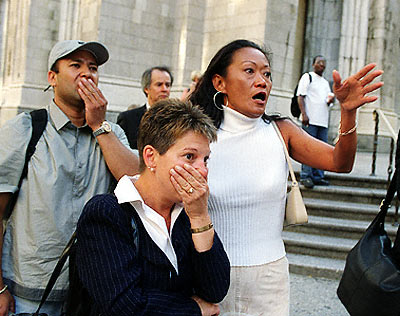 Survivors watch the towers collapse
Survivors watch the towers collapse
The crowd moved steadily along the walkway. A gasp rippled through the crowd, movement stopped, and people pointed up as the dust cloud bellowed over the five-story building like a slow motion wave. The crowd froze tight, shoulder to shoulder at the sight of the cloud.
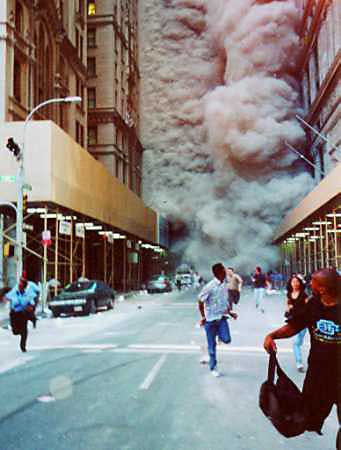 Onlookers run from the debris cloud
Onlookers run from the debris cloud
Fear of the dust cloud welled up in me; It’s here, the evil cloud will get us!
I rapidly considered my options for escape. With my left hand gripping the railing and the O2 tank in my right hand I felt trapped by the crowd. I could wait with the crowd and if people started dropping from some unseen gas or agent, I could leap over the rail into the water, sink to the bottom, breath off the O2 tank and swim to the sailboats. I could escape via the river if necessary.
A feeling of relief passed through the crowd. I looked up to see the dark cloud had stopped its movement towards us. The cloud hung there like a frozen wave. With relief, the people began to move again. The walkway opened up onto a wide four lane road heading north along the piers on the west side of Manhattan.
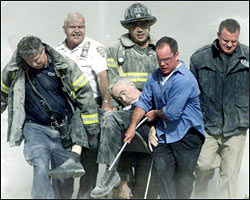 Firefighers carry the body of Mychal Judge, Chaplain of the FDNY
Firefighers carry the body of Mychal Judge, Chaplain of the FDNY
After walking a short way, I saw many ambulances lined up and parked along the southbound side of the road. It was another triage operation; gurneys were out on the street and they were treating people. The lead ambulance had “Flatlands Volunteer Ambulance Corps” painted on the side. I approached a guy who looked like the lead paramedic and for the fourth time that day, I volunteered: “I was trained as a medic in the army and I’d like to help.”
One of the paramedics gave me a reflective vest with the words "Flatlands Volunteer Ambulance Corps" written in magic marker. Despite my wingtip dress shoes, white shirt and wool trousers, I now looked a little more like an emergency worker.
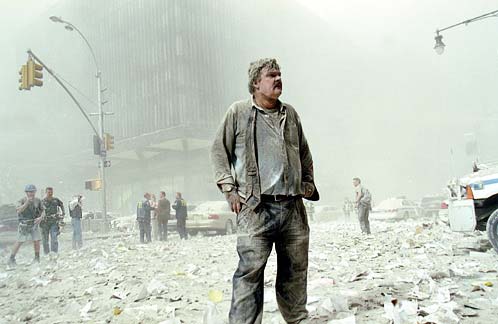 A survivor surveys the destruction
A survivor surveys the destruction
A man walked up with a huge reddened 'goose egg' on his head. He said he was running and debris hit him from above. We sat him on a folding chair for treatment and started to package him according to protocols for head and cervical spine trauma. I held his head erect while the paramedics wrapped a c-spine collar around his neck. With the neck immobilized we laid him on a backboard and placed him on a gurney. Then we rolled him over to a gym on the corner that was being used as a casualty collection point.
Back with the ambulance crew, I learned that they were members of a volunteer ambulance agency from Brooklyn. I was surprised to hear that this was a volunteer organization as they are not common in my home state of California, at least not in urban areas. One of the Flatlands volunteers was wearing a yarmulke and had the sidelocks of an Orthodox Jew.
Police and paramedic leads began shouting and pointing north. The order to withdraw to the north had come over the radio for fear of natural gas explosions. I clambered aboard the ambulance and rode north with the crew to Chelsea Pier.
At Chelsea Pier many ambulances were lining up in a very long line and our ambulance followed suit. The senior medic went into an ad hoc dispatch center within Chelsea Pier. I waited in the back of the ambulance with the crew. The lead paramedic returned with instructions: the plan was for ambulances dispatched from Chelsea Pier to move forward individually to pick up points closer to Ground Zero. Casualties would be taken to local hospitals or back to Chelsea Pier if the hospitals became overloaded. Chelsea Pier was being prepared by the Federal Emergency Management Agency (FEMA) to serve as a field hospital in order to cope with high numbers of expected casualties.
We waited there at Chelsea Pier for dispatch but few dispatches were being made and it looked like it would be a long wait. The lead medic collected contact information from each of us. Telephone lines were jammed. One of the guys had a cell phone and placed a call to his wife. We all gave contact information to the man’s wife over the phone and she would be calling our loved ones. I gave my wife’s name and telephone number wondering if the circuits would be open for such a call.
The radio news of the attack was interrupted for a citywide speech by Mayor Rudy Giuliani. He spoke well. The driver turned on the news radio as we waited for dispatch. None of the ambulances in the long line were dispatched. The casualty collection operations were not being used much. After what seemed like a long time, the lead paramedic announced that they were going to reform their crew with fresh volunteers from Brooklyn.
I got the hint that I wouldn’t be needed, that I’d probably be in the way. I shook a couple of the guys' hands and walked inside the building at Chelsea Pier.
Inside, FEMA was setting up a hasty MASH-like hospital with 30 emergency operating tables and 50 minor treatment stations all improvised out of folding banquet tables, a heap of medical supplies and staffed with volunteer doctors and paramedics. At the head of each makeshift operating table was a bright construction lamp on a stand.
I walked up to the main reception desk and I explained what I could do. I was assigned to work the door and do preliminary screening. I received a class on the use of triage tags, “toe tags” as the army would call them and waited for casualties.
I stayed at Chelsea Pier until 11 pm the night of September 11th, but sadly, very few casualties ever came to us.
The unfortunates of 9/11 either died outright in the initial attacks, or they were crushed when the buildings collapsed. Either you were outside and lived, or you were inside and died; this was the grim reality of the Twin Towers.
I stayed until I realized that there were plenty of volunteers lined up to help and no casualties coming. Then I took the train uptown to my hotel. Needless to say, that night I didn’t sleep well at all.
Now I have enemies.


